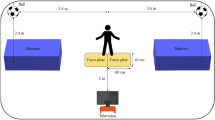These athletes worked out for themselves the optimal size of hand-held weights.
Abstract
Halteres1 (αλτηρεζ) are hand-held weights that were first used in the standing long jump in the eighteenth ancient Olympiad in 708 bc, and may have been introduced either to make the challenge more difficult or to extend the jumping distance2. Here we use computer and experimental simulations to determine the optimal mass of halteres that would be needed to maximally extend a standing long jump, and find that this corresponds closely to the size range of actual archaeological specimens. These halteres were made of stone or lead and weighed 2–9 kg, which we calculate would increase a 3-metre jump by at least 17 cm, indicating that their purpose was to boost the performance of pentathletes. Halteres may therefore be the earliest passive tool that was devised to enhance human-powered locomotion.
This is a preview of subscription content, access via your institution
Access options
Subscribe to this journal
Receive 51 print issues and online access
$199.00 per year
only $3.90 per issue
Buy this article
- Purchase on Springer Link
- Instant access to full article PDF
Prices may be subject to local taxes which are calculated during checkout


Similar content being viewed by others
References
British Museum (GR 1837.6-9.83, GR 1867.5-6.48), London, UK; National Museum, Athens, Greece; Archaeological Museum, Olympia, Greece.
Ebert, J. in Abhandlungen der Sächsischen Akad. Wissensch. Leipzig VIII 66, (Akademie, Berlin, 1963).
Beazley collection at http://www.perseus.tufts.edu
Wassmannsdorff, K. Monatsschrift für das Turnwesen 4 (1885).
Hill, A. V. Proc. R. Soc. Lond. B 127, 136–195 (1938).
Westing, S. H., Seger, J. Y., Karlson, E. & Ekblom, B. Eur. J. Appl. Physiol. 58, 100–104 (1988).
Perrin, D. H. Isokinetic Exercise and Assessment (Human Kinetics, Champaign, Illinois, 1993).
Minetti, A. E., Ardigó, L. P. & Saibene, F. J. Physiol. 472, 725–735 (1993).
Aristotle Problemata 3, 705 a, 12–19.
Jüthner, J. Antike Turngeräthe (Vienna, 1896).
Author information
Authors and Affiliations
Corresponding author
Ethics declarations
Competing interests
The authors declare no competing financial interests.
Rights and permissions
About this article
Cite this article
Minetti, A., Ardigó, L. Halteres used in ancient Olympic long jump. Nature 420, 141–142 (2002). https://doi.org/10.1038/420141a
Issue Date:
DOI: https://doi.org/10.1038/420141a
This article is cited by
-
Elite long jumpers with below the knee prostheses approach the board slower, but take-off more effectively than non-amputee athletes
Scientific Reports (2017)
-
Unidirectional motion using rotating masses along figure-eight-shaped trajectories
Journal of the Brazilian Society of Mechanical Sciences and Engineering (2015)
-
Weights gave Olympian long-jumpers a hand
Nature (2002)
Comments
By submitting a comment you agree to abide by our Terms and Community Guidelines. If you find something abusive or that does not comply with our terms or guidelines please flag it as inappropriate.



